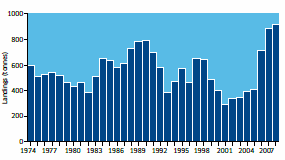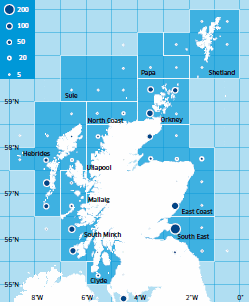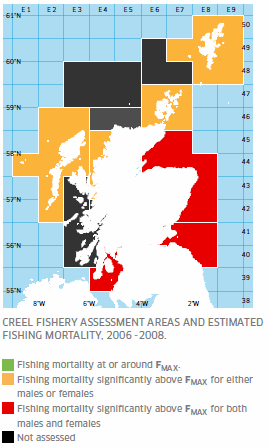Introduction
The earliest records of lobster fishing in Scotland date back to the 12th century when lobster was caught by hand using ‘crooks’ and hoop nets. With the development of baited traps, exploitation on a more commercial basis was developed, and today creel fishing for European lobster supports very important local fisheries around the Scottish coast. Lobster landings taken by Scottish vessels increased substantially from 290 tonnes in 2001 to about 920 tonnes with a value of over £9.8 million in 2008. In recent years, the majority of lobster landings have come from the South East, Hebrides, Orkney and South Minch.
Biology and life cycle

The European lobster is found all around the coast of Scotland, typically on hard ground in relatively shallow waters and on the fringes of kelp beds. The diet of the adults consists mainly of benthic invertebrates such as crabs, molluscs, sea urchins, polychaete worms and starfish, but may also include fish and plants.
The majority of lobsters are caught in waters shallower than 30 m, but they may be found as deep as 150 m. Substrate and suitable shelter are thought to affect the size of lobsters and population density, with larger lobsters being found on more exposed grounds. Lobsters are generally not thought to undertake extensive migrations, moving only a few miles along the shore. Recent studies of the north east coast of England have however, indicated seasonal offshore movements of berried females. A recent study on the genetic variation of lobsters reported very low levels of genetic variation amongst lobster populations in Europe.
The growth rate of lobster is highly variable. Lobsters recruiting into the fishery at the minimum landing size of 87 mm carapace length (CL) can be anywhere between four and 12 years old. In common with other crustaceans, lobster shed their shell (moult) in order to grow. The main moulting period is in June-July. Juveniles moult more frequently and grow faster than older animals. Mating occurs just after moulting while the female’s shell is still soft. Size at maturity in females varies across Scotland; females mature at smaller sizes in the South East than in the Hebrides.

Female lobsters produce between 10 and 15 thousand eggs. Once fertilised, the eggs develop internally for up to a year, after which they are carried under the ‘tail’ for nine to 11 months until they hatch. ‘Berried’ female lobsters have much reduced feeding and growth rates and low catchability during the egg bearing phase.
Lobsters can grow very old, and the potential reproductive life span of a female lobster is in excess of 40 years. Amongst the largest reported lobsters in the UK are a female of 157 mm CL, thought to be 72 years old, and an 11 lb (5 kg) lobster from the Hebrides estimated 190 mm CL.

Management advice
The lobster fishery is not subject to EU TAC regulations or national quotas. In Scotland, vessels landing lobsters are required to have a licence with a shellfish entitlement. Vessels without this entitlement are only allowed to land a limited amount (five lobsters per day). The main regulatory mechanism is a minimum landing size of 87 mm CL in all areas except Shetland (90 mm CL, under the Shetland Regulating Order). A maximum landing size of 155 mm for females is also enforced.
Assessment
Age determination is generally not possible for animals which moult, and application of agestructured assessment methods to crustacean stocks is problematic. Length Cohort Analysis (LCA) is the method used for assessing lobster stocks. It uses official landings and length frequency data collected as part of the Marine Scotland Science market sampling programme.
LCA results are calculated in terms of yield-per-recruit and biomass-per-recruit relative to changes in fishing mortality, providing a framework for evaluation of management measures. Assuming a direct relationship between fishing mortality and effort, generally, lower levels of fishing effort will result in an increase in stock size and a reduction in landings. A higher level of fishing effort will reduce total stock biomass, but landings may also fall, as animals are caught before they have had time to grow to a size that would contribute much weight to the yield (growth overfishing). In between these lies FMAX, the fishing mortality rate that maximizes yield per recruit.

The changes that the LCA predicts are long term (equilibrium). The method does not provide any indication of short-term stock dynamics or recruitment over-fishing. Assessments are performed on a regional basis for males and females separately.
State of the stocks
Results of assessments based on LCAs for the period 2006-2008 for seven of the twelve assessment areas summarising estimates of fishing mortality in relation to the reference point FMAX are shown on the map (see p62). There were insufficient sampling data from the South Minch, Mallaig, North Coast, Sule and Papa areas to conduct LCAs. Of the assessment areas, all were growth overfished to some extent, particularly male stocks.
In the areas of major importance for lobster landings, fishing mortality is estimated to be significantly above FMAX for both males and females in Clyde, East Coast and South East. In Shetland, Orkney, Hebrides and Ullapool, fishing mortality for female stocks is close to FMAX while males are being fished above FMAX.
Management advice
Overall, assessments for the period 2006-2008 show that most lobster stocks in Scotland were fished close to or above FMAX, which is above optimum effort level to achieve the maximum yield-per-recruit. A higher yield and biomassper- recruit in the long term could potentially be obtained in all assessment areas by reducing the level of fishing mortality (effort).
Further Reading
| - | You can view the full report by clicking here. |

